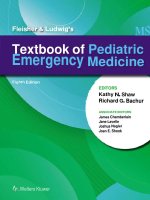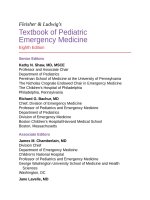Pediatric emergency medicine trisk 0308 0308
Bạn đang xem bản rút gọn của tài liệu. Xem và tải ngay bản đầy đủ của tài liệu tại đây (74.33 KB, 1 trang )
In many cases, optimal patient care mandates appropriate and safe extrication or
rescue from the patient’s situation or environment. It is critical that EMS
personnel possess or have immediate access to the expertise, tools, and
equipment necessary to safely remove patients from entrapment or hazardous
environments. It is beyond the scope of this document to describe the extent
of these. Local circumstances and regulations may affect both the expertise
and tools that are maintained on an individual ground ambulance, and on any
other rescue vehicle that may be needed to accompany an ambulance to an
EMS scene. The tools and equipment carried on an individual ground
ambulance need to be thoughtfully determined by local features of the EMS
system with explicit plans to deploy the needed resources when extrication or
rescue is required.
a Latex-free
equipment should be available.
From American Academy of Pediatrics, American College of Emergency Physicians, American College of
Surgeons Committee on Trauma, et al. Equipment for Ground Ambulances. Prehosp Emerg Care
2014;18(1):92–97. Reprinted by permission of Taylor & Francis Ltd, www.tandfonline.com .
Financial considerations, importantly, may not influence the decision making
on the part of either the transferring or receiving facility for patients whom have
not been stabilized to the fullest capabilities and capacity of the referring
institution. The Consolidated Omnibus Budget Reconciliation Act (COBRA) of
1985, and the federal Emergency Medical Treatment and Active Labor Act
(EMTALA) regulations, which were passed as part of COBRA, prevent financebased emergent transport decisions. Interfacility transport cannot be used by the
referring institution as a method to avoid initial assessment, stabilization, or
intervention. Similarly, the receiving institution cannot use a patient’s ability to
pay to determine transport acceptance; if the receiving institution can provide the
higher level of services needed by the patient, and has the current capacity to
manage the patient, the transport cannot be declined.
To adequately prepare for interfacility critical care transport (CCT), a transport
system should have access to specialized equipment, trained personnel, and
appropriate certifications and licenses. The transport system is responsible for
ensuring the safety of the patient, team, and family members during the transport,
as well as guaranteeing that the patient is cared for in the appropriate medical
environment. The transport system should have identifiable medical and program
directors who are responsible for ensuring adequate training and education, as
well as continuing competency assessment of personnel and process. The medical
and program directors are ultimately responsible for ensuring a safe, reliable
transport system.









